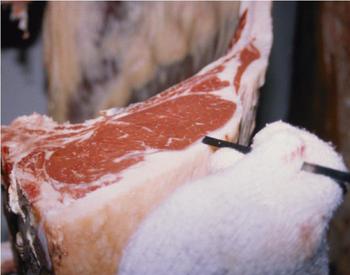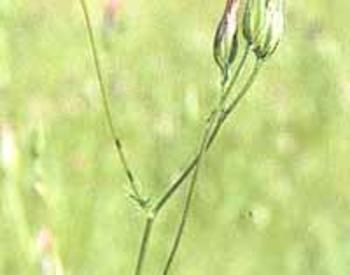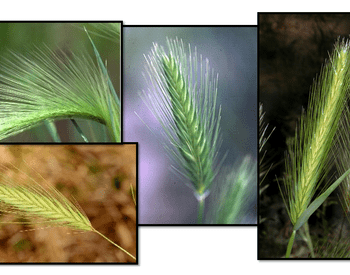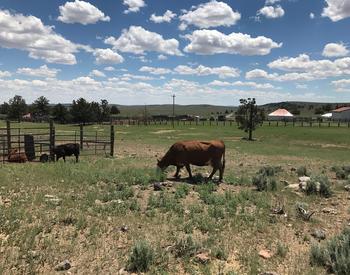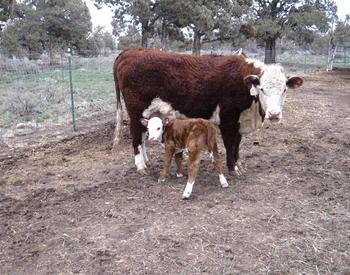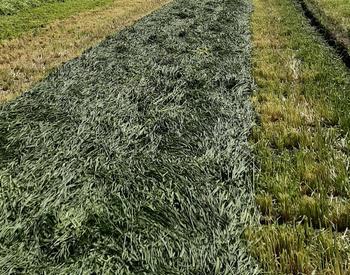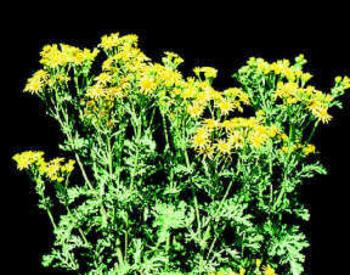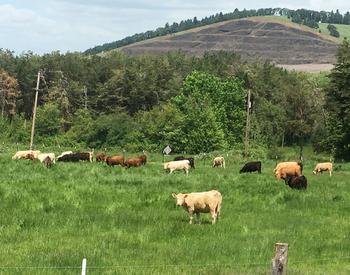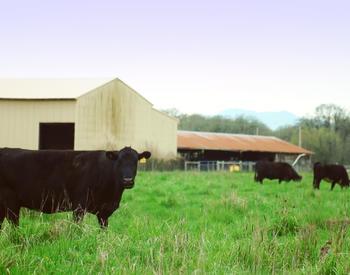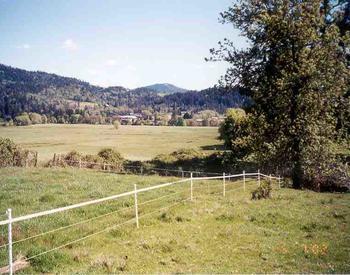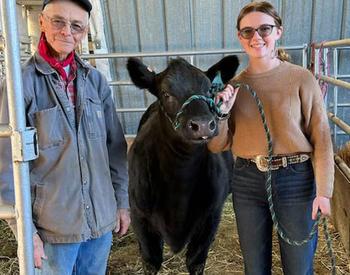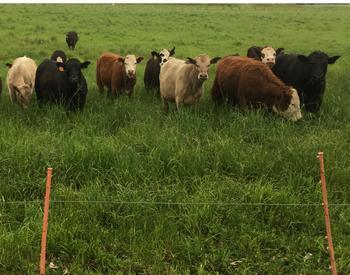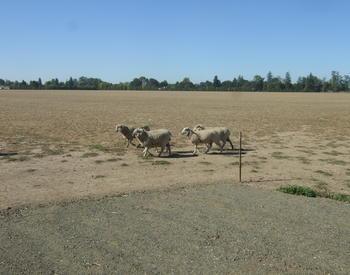Synopsis
Spring-planted warm-season grasses and brassica forages increased nutritional content of the diet available to grazing cow-calf pair, but pastures were slow to establish and weaning weights were not improved.
Summary
The objective of this experiment was to determine whether grazing cow-calf pairs on warm season grasses and brassica pastures would extend the grazing season and positively affect calf weaning weights, feedlot performance, carcass characteristics and ranch profitability.
Treatments were pasture type, extended season pasture (EXT) made of newly planted sorghum × Sudangrass and brassica forages and control pasture (CON) from an existing field of cool season forage. Thirty cow-calf pairs (steers only) were stratified by calf weight and assigned to treatments randomly. Each pasture type was divided into 3, 5-ac paddocks (replicates of experimental unit) and grazed with 5 cow-calf pair until late summer weaning.
Cool spring weather slowed EXT establishment and growth so that grazing was delayed until mid-August, allowing for only a 14-d grazing period. Forage yield of EXT tended to be lower than that of CON (2.2 and 3.4 t/ac, respectively). In contrast, CP (10.3% and 6.7%) and TDN (69% and 56%) were higher (P < .04) for EXT compared to CON, respectively. Calf weaning weights (205-d adjusted) were not different (P = 0.167) for EXT and CON (637.2 and 679.2, respectively).
In yr 2, planting strategy was adjusted. However, growing conditions were again less than optimal, pasture was not sufficient for grazing and no additional data were obtained. Early establishment of warm season forages in the Pacific Northwest can be severely impacted by weather, making it difficult to graze spring calving, cow-calf pair for the purpose of improving early summer weaning weight.
Introduction
Calf weaning weight is influenced by attributes of the sire and dam, the calf itself and environmental factors. Age and sex of calf and age of dam were recognized by Minyard and Dinkel, (1965) and milk yield documented by Rutledge et al. (1971) as having significant effects on calf weaning weight. And, we know that a major determinant of milk yield is the quality and quantity of feed a cow receives during lactation.
The nutrient content and digestibility of cool season forages decreases as the forage matures and environmental conditions warm in the late spring and early summer. During the summer months, protein and energy of most western Oregon forages dip below the nutritional requirement of lactating cows and growing calves, limiting milk production and calf growth. Increasing calf weaning weights can improve profitability of beef ranches if the cost of that gain is low relative to sale price of the added gain.
Warm season grasses, such as sorghum × Sudangrass (S×S), have young, fast growing (vegetative) foliage throughout most of the summer months, and have high nutritional value compared to animal nutrient requirements. These forages can be used to extend the grazing season beyond the time when cool season forages decrease growth or go dormant, and decrease in quality. Additionally, forage brassicas can be planted in the spring or fall to augment these and other forages.
Producers in western Oregon have planted the above forage types together for use in grazing sheep and lambs, weaned calves and adult cattle. There is potential for grazing lactating cows and calves (cow-calf pairs) on S×S and brassica forages for the purpose of improving calf weaning weights.
Negative consequences to livestock grazing these types of forages include the possibility of prussic acid and nitrate poisoning, goiters and digestive upset. Producers and service providers in Oregon need more information on growing and using the plants for feeding livestock.
Feedlot performance and carcass characteristics are influenced by previous management and plane of nutrition. Cattle subject to novel forages could have differences in growth and end product. Therefore it is prudent to follow these attributes when trying new forages and feeding regimens.
At the Oregon State University Soap Creek beef ranch, livestock graze non-irrigated pastures containing predominantly tall fescue, subterranean clover, and annual and perennial ryegrass. Calf weaning weight could be limited by the decrease in quality of these forages in the summer. Therefore, management was seeking to economically increase calf weaning weights through improving plane of nutrition for lactating cows and providing high quality forages for their suckling calves.
The objective of this experiment was to compare weaning weight of calves where cow-calf pair grazed S×S and brassica forages to extend the grazing season (EXT) compared to those grazing conventional, cool-season forages in control pastures (CON). Additional evaluations of the calves included feedlot performance and carcass characteristics.
Other objectives of this study included providing a demonstration, teaching and learning venue for faculty, students, and beef industry producers and service providers; and to provide recommendations on production methods, safe grazing and economic information on effectively utilizing these forages.
Materials and methods
Pastures (15 ac each) were set up in western Oregon at a site where soils dry out mid-spring each year and ambient temperatures reach in excess of 90° during the summer. Control pastures used cool season forages (tall fescue, ryegrass, subterranean clover, and meadow foxtail) that were already established on the site.
To condition the forage for use in this trial, the pasture was grazed down to three inches and then allowed to regrow for use as the CON pasture. At the time of graze-down of CON, pastures for the EXT were established by planting S×S (variety, Green Treat A+ at 20 lb/ac seeding rate) and brassicas (Graza Grazing Radish and Hunter Turnip, both at 2 lb/ac).
Seed was drilled into a well-prepared seedbed and the planting rolled to firm the ground. A mid-May planting time was chosen in order to ensure good moisture for establishing the pasture and to provide a 60-day grazing period (early July through calf weaning in September) for the experiment.
Field fence was used to secure the pasture perimeters, and water, trace mineral salt, and round bale feeders (EXT only) were set up. Each pasture type (EXT and CON) was divided into 3, 5-ac paddocks using electric fencing. Thirty cow-calf pairs (steers only) from a spring calving herd were stratified by calf weight and assigned randomly to treatment paddocks (experimental unit). That is, each treatment (CON and EXT) was replicated three times (paddocks) using five cow-calf pairs per paddock.
Forage yield was estimated at the start of the experimental grazing period from samples collected using a 0.1 meter square hoop (four hoops per paddock). Samples were weighed in the field using a tarp and scale system. Forage quality was estimated from samples collected from paddocks over the growing season.
All samples were placed in plastic bags and stored in the refrigerator for up to 1 wk and then dried in a forced-air forage drier on the OSU Corvallis campus. Samples were then placed in paper bags and stored for laboratory analysis and calculations, including dry matter (DM), crude protein (CP), acid detergent fiber (ADF), neutral detergent fiber (ADF), non-fiber carbohydrates (NFC), total digestible nutrients (TDN) and relative feed value (RFV).
Prior to the start of the grazing period, readiness of EXT pastures for grazing was assessed by monitoring plant height (minimum 18 in) and anti-quality factors, prussic acid (hydrocyanide or HCN gas) and nitrates. The presence of prussic acid was evaluated using Cyantesmo Paper (Macherey- Nagel GmbH & Co. KG, Dueren, Germany) and the presence of nitrates was evaluated using Nitrate Precision Test Strips (Sargent-Welch, Buffalo, NY).
Cow-calf pairs that had been grazing cool season forage on an adjacent pasture were acclimated to their treatments (EXT and CON) by introducing them to small sections of their pastures, two hours at a time for three days. To guard against digestive upset from the new forages, cattle in EXT had free access to low-quality (7% CP) grass and clover hay placed in round bale feeders.
During the experimental grazing period, paddocks were strip-grazed with cattle controlled using a single line of electric fence wire. The grazing period started at pasture readiness (mid-Aug.) and continued until calf weaning time (Sept. 1). Under these conditions the grazing trial was limited to 14 days. Pairs were gathered from pastures and herded to nearby facilities where they were separated. Cows were evaluated for pregnancy status, and calves were weighed immediately after. Unshrunk, off-the-cow calf weaning weights, adjusted to 205 days of age, were calculated (BIF 2010).
The experiment was repeated for a second year. To improve establishment and growth of S×S, EXT pasture was planted at a soil temperature of 60° F (mid-June reading from nearby OSU Hyslop Farm station). To help with moisture retention, the scant forage that remained from year one was mowed to the soil level using a Brush Hog and seeding was done by drilling without significant tillage.
Single factor ANOVA was used to detect treatment differences for forage yield, nutrient content and 205-d adjusted calf weaning weight. Pasture was the experimental unit, replicated in paddocks. The experimental protocol was reviewed and approved by the Oregon State University Animal Care and Use Committee.
Results
In year 1, brassica forages grew well and were ready to graze by early July. Cool season forages in the CON pastures also grew well in the unusually cool spring weather. However, the growth of the S×S (a warm-season grass) was impaired by this weather so that grazing was delayed until mid-Aug, limiting the grazing period to 14 days. By then the brassica forages were starting to mature (leaves were large and starting to yellow). The soils turned dry and rainfall was scant.
The S×S plants lacked vigor and failed to grow taller than 24 in. high during the growing season. Mid-May plantings of S×S from other sites in Oregon also reported slow growth and low yields, and attributed that to cool weather after planting date. However at one site, planting was delayed until mid-June and good establishment and growth that exceeded other plantings in height and apparent yield was observed. Cool season forages grew well in the cool, wet spring.
No S×S samples tested positive for elevated nitrate levels. However, one week before the anticipated start date for grazing, one sample tested slightly positive for prussic acid. At that time, the majority of the S×S plants had a height of 18 to 20 in. Subsequent testing did not find other positive samples.
As part of the outreach component of this study, six other sites around southern Oregon were tested for nitrates and prussic acid and none were positive. There was no apparent stress on these plants that would suggest otherwise. Cattle readily consumed the novel forages during the acclimation and experimental grazing periods, and no digestive upsets were observed. Hay provided free choice was consumed at a low rate, approximately 2-3 lb per day by EXT cattle. The cows and calves were eager to enter new allotments of pasture.
Average nutrient content and yield of EXT forages at various times over the grazing season are listed in Table 1. Comparison of EXT and CON for the August 19 sampling date is presented in Table 2. Forage yield of EXT tended to be lower (P = 0.056) than that of CON (2.2 and 3.4 t/ac, respectively). In contrast, CP (10.3% and 6.7%) and TDN (69% and 56%) were higher (P < 0.036 and P < 0.0001) for EXT compared to CON, respectively. Fiber components (ADF and NDF) were lower (P = 0.0001) in EXT, indicating a more digestible forage with more intake potential than the CON forage.
Additionally, non-fiber carbohydrate was higher (P = 0.0001) for EXT than for CON. These fiber and non-fiber differences are reflected in the TDN values. However, the higher nutrition available in the pastures did not improve calf weaning weights, which were not different (P = 0.167) between EXT and CON groups (637.2 and 679.2, respectively; Figure 1).
| Item | July 20 | Aug 19 | Aug 24 | Sept 14 |
|---|---|---|---|---|
| DM (%) | 20.2 (3.5) | 25.7 (4.0) | 28.7 (4.3) | 23.2 |
| Yield (ton/ac) | 1.6 (0.2) | 2.2 (0.5) | 2.9 (0.1) | 2.6 |
| CP (%) | 12.2 (2.5) | 10.3 (0.8) | 8.4 (1.0) | 2.6 |
| ADF (%) | 15.1 (0.9) | 16.0 (1.4) | 17.7 (0.9) | 19.2 |
| NDF (%) | 20.4 (0.8) | 21.1(3.9) | 22.3 (1.6) | 25.8 |
| NFC (%) | 56.8 (2.3) | 58.2 (4.3) | 58.8 (1.8) | 52.3 |
| TDN (%) | 69 (0.6) | 69 (1.5) | 68 (1.0) | 67 |
| RFV | 352 (13) | 344 (55) | 314 (25) | 267 |
| Treatment | EXT | CON | SEM | P-level |
|---|---|---|---|---|
| DM (%) | 25.7 | 54.7 | 1.36 | 0.0002 |
| Yield (ton/ac) | 2.21 | 3.40 | 0.33 | 0.056 |
| CP (%) | 10.3 | 6.7 | 0.84 | 0.0036 |
| ADF (%) | 16.0 | 38.1 | 4.95 | 0.0001 |
| NDF (%) | 21.1 | 63.7 | 9.60 | 0.0001 |
| NFC (%) | 58.2 | 22.1 | 8.14 | 0.0001 |
| TDN (%) | 69 | 56 | 2.86 | 0.0001 |
| RFV | 344 | 86 | 59.27 | 0.0013 |
Because the grazing season in yr 1 was considerably shorter than anticipated, subsequent data on calf feedlot performance and carcass characteristics were not collected. Studies on grazing to improve calf performance should be at least 60 days (ideally 100 days) in order to show improvements (William Ocumpaugh, Texas A&M, personal communication,).
Although planting strategy was adjusted for the second experimental year, growing conditions were again less than optimal. Moisture was limiting and the soil was very hard. Some of the seeds germinated but were unable to grow. Pasture growth was not sufficient for grazing and no additional data were obtained.
Conclusions
Establishment and growth of warm season grass and brassica mixed pastures in the late spring was severely impacted by unseasonably cold weather and the pastures were not ready early enough to graze spring calving, cow-calf pair for the purpose of improving weights of summer-weaned calves. However, those pastures contained high quality forage that could extend the grazing season for weaned calves or other livestock into the later summer months.
More studies need to be conducted to evaluate grazing opportunities for utilizing these forages in Oregon. To increase the probability of success, planting SxS and other warm season forages at a soil temperature of at least 60° on a site with predicable moisture is suggested. And, using separate fields for brassica plantings would provide more flexibility in grazing opportunities.
Upon finding appropriate planting and grazing scenarios, calves should be followed into the finishing phase and packing house where average daily gain, feed efficiency, carcass quality and yield grade can be examined, Economic data should be assembled and an analysis completed to determine any differences in unit cost of production ($/cwt of beef) between calves grazing SxS and brassica forages and other feeding regimens. This study provided a demonstration, teaching and learning venue for faculty, students, and beef industry producers and service providers. More information has been gathered for providing recommendations on production methods and safe grazing.
Acknowledgments
This research study was financially supported by the Oregon Beef Council and the Byron Scott Forage Funds. Authors thank Ioka Marketing and PGG Seeds for the donation of seeds, Roger Olsen for custom farming, and student assistants Landon Grizkowski, Alvin Kuenzie, Owen White and Caroline Odom.
Literature cited
Armah-Agyeman, et al. 2002. OR. State Univ. Ext. Com. EM 8793.
Beef Improvement Federation. 2010.
Hall. 2011. Penn State Agronomy Facts 33 Rutledge et al.1971. J. Anim. Sci. 33(3):563-567 Minyard and Dinkel. 1965. J Anim. Sci 24:1067- 1071.
National Research Council. 2000. Nutrient Requirements of Beef Cattle.
Tatum et al. 1988. J. Anim. Sci. 66:1942-1954.
Undersander et al. 2011 Purdue Univ. Alt. Field Crops Man.
Zar. 1984. Biostatistical Analysis. 2nd Ed. Prentice- Hall
This document is part of the Oregon State University - Beef Cattle Library. Prior to acceptance, this document was anonymously reviewed by two experts in the area.
- 1 a b Values are means with standard deviation listed in parentheses, except for the single-sample values for Sept 14.
- 2 a b Dry matter (dm), crude protein (CP), acid detergent fiber (ADF), neutral detergent fiber (NDF), non fiber carbohydrates (NFC), total digestible nutrients (TDN), and relative feed value (RFV).
